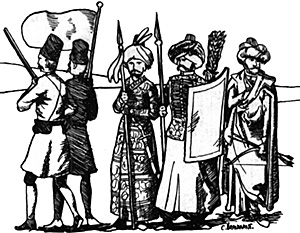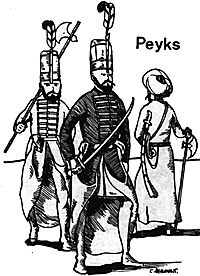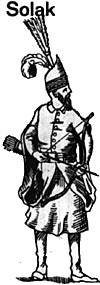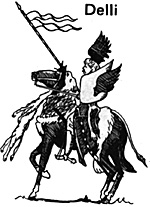The Janissaries Part 1: History, Uniforms, and Tactics [113]

Usually the backbone of European armies, the common foot-soldier hardly gets a mention when the Turkish army is described. The three figures on the right of my sketch are probably fairly typical of the feudal levies that accompanied their lord: and spahis on campaign. The man in the centre of this group carries the peculiarly shaped Turkish shield, almost rectangular, but with one corner over-extended, so that in many pictures it looks like a badly drawn piece of perspective. The figure with the bow comes from a drawing by Alorecht Durer, of about 1499. How accurate it is one cannot be sure, because Durer himself never went to Turkey; he copied this figure from the work of the "Hausbuchmeister", adding the bow himself to make it look more military!
The two soldiers on the left, with the flag, are rather interesting. They come from a
miniature showing Kenlan Pasha marching against rebels in Macedonia, dating from 1630. A whole group of infantry is shown wearing identical dress of short tunic with loose sleeves, knee-length breeches and stockings. They all carry muskets, except for the colour bearers, who also wear darker uniforms. Who
these troops are I do not know; perhaps they are local Macedonian levies. They certainly have a
distinctly western appearance.
 PEYKS:
PEYKS:
The Peyks were the bodyguards of the pashas, and the left hand pair are those of Lala Mustafa Pasha c. 1580. The tall gold caps are adorned with feathers and caftan skirts are drawn up into the belt in the usual manner. The garments are in varying colours, with gold lace. The turbanned figure is one of the bodyguard of Kenlan Pasha shown on the march in Macedonia; all the foot soldiers armed with scimitars in this miniature carry them in the fashion shown. Presumably a long, heavy scabbard was not the best thing to have dangling around the legs on a long march.
 SOLAKS:
SOLAKS:
The bowmen bodyguards of the sultan, possibly drawn from amongst the officers of the
Janissaries, numbered 400 men. They wore the silk spahi with gold trim, with tight stockings made of dyed suede. Details of dress vary from source to source Knotel reproduces three, each with different styles of headgear. The basic cap stays the same, but one has the plumes at the side, one at the front and one in the middle,
with some alteration in the
design of the crown of the hat
to allow for this. The figure I
have chosen to reproduce has the
crest in the centre, and is
interesting because of the way
in which the tails of the spahi
are not tucked into the sash at
the waist but are in fact
continuations of the loose
sleeves which hang from the
shoulder. The uniform is from
Nicola de Nicolai (1576) via
Knotel.
 DELLIS:
DELLIS:
The weird horseman with the eagle's wings on his shield and cap is a delli. These irregular scouts were volunteers drawn from the feudal light cavalry. The animal skins covering both man and horse, together with the wings, were designed to overawe the enemy at first sight. Foot long spurs were worn on the yellow, pointed boots.
Beneath his left thigh he carries a "Panzerstecher". This is Knotel's word for the weapon, which is translated as "boar-spear sword". Literally, it would translate as "armour piercer", I think, and one can only presume that it served the function of a tin opener when tricky characters like the Knights of St. John were met with in battle! Volunteers from the dellis often formed the bodyguards of Turkish governors.
IAYALARS:
Armed with round shield and scimitar, the Iayalars were a fanatical Moslem sect, lacking in discipline and training. They were clothed in the skins of wild beasts, enriched with varying designs and characters in silver, and wore gilded steel helmets. Maddened with hashish before the start of a battle they would go into the fray with a frenzy and a lust to kill.
AKANZI:
Mentioned by Knotel as volunteers armed with bows and arrows. They may have fought as skirmishers ahead of the main line of battle.
SEGBANS:
A form of dragoon, they guarded the baggage train.
TOPJU:
These were the cannoneers, up till the last always the most reliable troops of the Sultan. Whereas in western Europe gunnery was for a long time regarded as either a mysterious art or as sheer mechanical drudgery unworthy of a gentleman and a soldier, in the Ottoman Empire it was always looked upon as one of the most superior branches of the army. The first important use of Turkish artillery was at the siege of Constantinople in 1453; the exceptionally large cast bronze guns used to batter the walls were among the most formidable bombards ever built. One of them weighed 19 tons and hurled a 600 pound stone; it took 60 oxen and 200 men to move it. vihen a British squadron attacked Constantinople in 1807, it met with some of these monsters still in working order -- one roundshot is recorded as having laid low not less than 60 men.
The large part played by siege warfare in Turkish campaigns enabled them to bring bombardment to a fine art, though it also meant that the Ottoman artillery tended always to be heavier than that of European armies and thus slower in movemen t and firepower, and less use in open battle. At Malta, in 1565, the attackers brought some 80 odd pieces of ordinances including 60-, 80-, and 120- pounders, firing stone, marble and iron shot with devastating effect. This was a ratio of about 1 gun to every 400 men. In command of all the artillery of the empire was the Topji Bashi, the Grand Master of Artillery.
PIONEERS, ENGINEERS AND MINERS:
Closely associated with the role played by the artillery, the miners and engineers were generally composed of Greeks and Armenians. At Malta, a corps of Egyptian engineers was employed, who were highly skilled in siege work, and succeeded in tunnelling through the sand and limestone of the island to explode a mine beneath the bastion of Castile.
JEBEJI:
The armourers, obviously a very important section of the army.
BIBLIOGRAPHY:
Toman - "A Book of Military Uniforms and Weapons".
Bradford - "The Great Siege, Malta
1565".
Knotel - "Handbuch der Uniformkunde."
Knotel - "Heere der Vergangenheit".
Meredith-Owenp -'Turkish Miniatures".
Anderson
"Europe in the Eighteenth Century".
Waetzoldt "Durer und Seine Zeit".
Manucy "Artillery
Through the Ages".
Wallace "Islamic Arms and Armour" (article in "Discovering Antiques" Magazine)
ENCYCLOPAEDIA BRITANNICA - Various references.
LAPOUSSE DICTIONNAIRE ENCYCLOPEDIQUE.
Back to Table of Contents -- Wargamer's Newsletter # 114
To Wargamer's Newsletter List of Issues
To MagWeb Master Magazine List
© Copyright 1971 by Donald Featherstone.
This article appears in MagWeb.com (Magazine Web) on the Internet World Wide Web.
Other articles from military history and related magazines are available at http://www.magweb.com